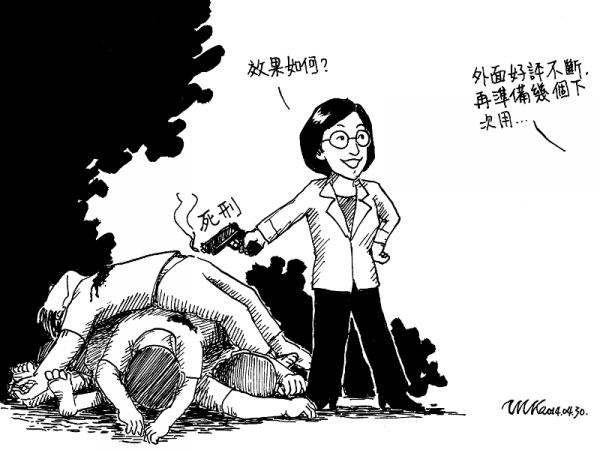The Ma Government’s Shift of Focus through the Death Penalty in the Chronicle of Events
The Ma Government’s Shift of Focus through the Death Penalty in the Chronicle of Events
Since Taiwan resumed carrying out the death penalty in 2010, all executions “coincidentally” responded to setbacks of popularity that the Ma government encountered. As a result, the public unceasingly questions whether the Ma government avoids facing difficulties by means of killing people as well as whether the blood of the convicts is been sacrificed in order to secure the prestige of the government. By means of the chronicle of events listed as follows, we hope to make the scheming of the government evident to everyone.
(圖片出處:畫漫畫 話漫畫)
2006–2009, Taiwan temporarily stopped carrying out executions.
November 2009 — The Kuomintang (KMT) Legislator Wu Yu-Sheng was exposed of having been engaged in extra-marital sexual intercourse, leading to unceasing public ridicule as well as a devastating setback in reputation.
February 2010 — During an interpellation at the parliament, Legislator Wu Yu-Sheng demanded the Ministry of Justice to carry out the executions of the 44 death row inmates.
April 2010 — While the Economic Cooperation Framework Agreement (ECFA, a trade agreement between Taiwan and China) controversy intensifies, civil voices for rebound become increasingly louder.
April 30, 2010 — The Minister of Justice, Tseng Yung-fu, executed four death row inmates.
January-February 2011 — An investigation on the wrongfully convicted Chiang Kuo-ching Case was carried out by the Control Yuan (an ombudsman organization).
March 4, 2011 — The Minister of Justice, Tseng Yung-fu, executed five death row inmates.
June 2012 — An outbreak of a political scandal involving the then Secretary General of the Executive Yuan, Lin Yi-shih, who involved in a bribery case when he was the former KMT Legislator.
November 2012 — An outbreak of a major corruption scandal involving the public prosecutor Chen Yu-chen.
December 1, 2012 — A homicide of a young boy occurred in Tainan. The public was in great agitation after the Tainan homicide incident. With a rising rate of unemployment and a deterioration of the economic situation, the government was discontent of being incapable to maintain public order.
December 21, 2012 — The Minister of Justice, Tseng Yung-fu, executed six death row inmates.
March 2013 — An outbreak of a political scandal involving Lai Su-ju, a KMT Taipei City councilor. A chain of revealed political scandals was followed by an upsurge of public discontent.
April 19, 2013 — The Ministry of Justice conducted the prison transfer of the former President Chen Shui-bian from Taipei to Taichung. The Proposal for the Fourth Nuclear Power Plant Referendum was decided by vote at the Legislative Yuan.
April 19, 2013 — The Minister of Justice, Tseng Yung-fu, executed six death row inmates.
March 18, 2014 — The Anti Cross-Strait Service Trade Agreement (CSSTA) occupation of the Legislative Yuan. The Sunflower Movement campaigning against the CSSTA lasted for 24 days.
April 27, 2014 — The Anti-Nuclear occupation of Zhongxiao West Road.
April 28, 2014 — In the early morning, Taipei City Major Hau Lung-pin gave orders to water tankers to enforce a dispersal of the masses, causing many people injured.
April 29, 2014 — The new Minister of Justice Luo Ying-shay executed five death row inmates.
May 29, 2015 — A homicide of a young girl occurred in an elementary school in Beitou. The incident stirred the social tranquility and caused a panic among parents. Some agitated people demanded immediate executions for all death row inmates.
June 3, 2015 — The Chairperson of the Democratic Progressive Party (DPP), Tsai Ing-wen, visited the U.S.. Her trip to the U.S. included visiting the American government officials during June 2-5 and the visit to the White House on June 3. It marked a major event in Taiwan’s political circles.
June 5, 2015 — The Minister of Justice, Luo Ying-shay, executed six death row inmates.
Taking into account the above-listed chronicle of events, can there be any doubt about the government’s calculations when implementing capital punishment?



